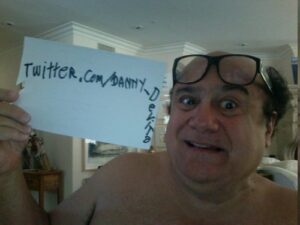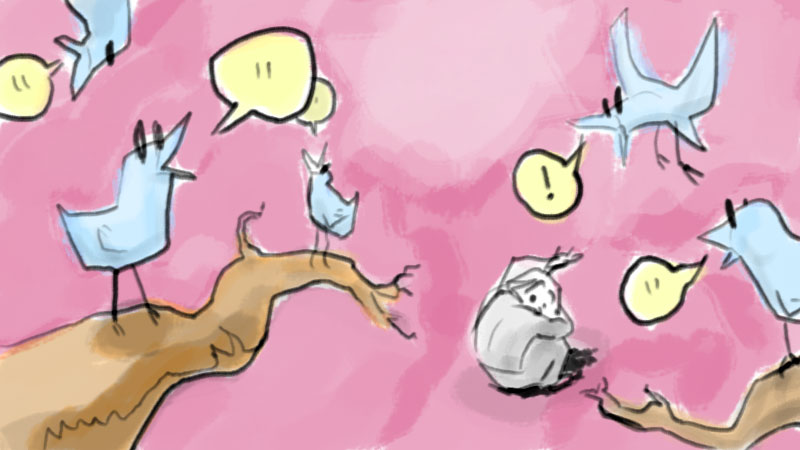 One of the reasons it is often hard to explain twitter to someone who doesn’t use it is that everyone tweets in their own way.
One of the reasons it is often hard to explain twitter to someone who doesn’t use it is that everyone tweets in their own way.
How you use twitter is often closely linked to what device or software you use. I’ve noticed who I pay attention to in my collection of followed people is different when I’m using the twitter desktop client, the website and flipboard on the iPad. (Hey everyone! This guy has an iPad!)
When I was first made aware of twitter, it seemed to be popular among people who had iPhones and the like. This made sense because the design of the twitter website at the time wasn’t very engaging and didn’t handle the emerging features like hashtags and mentions in a way that I found useful. I’d go to twitter, see a list of disconnected status updates and shrug.

However, if you used a twitter client on your phone Twitter made sense. It was a broadcast text messaging platform. Users grokked that and used it that way. Facebook makes sense if you’re sitting at a computer, twitter works when you’re on the go.
Now there seems to be as many ways to use twitter as there are live twitterers (tweeters? twerps?) I think that’s fine, of course, but I find myself unfollowing people that don’t use twitter in a way that I can handle. You’ve probably experienced the situation where you follow someone and only then note that they post non stop updates about every sensation they experience. It’s a mess.
Of course, how I want to use it is highly dependent if I’m on the iPad in flipboard or using the twitter for mac client or… well, let’s just say I’m hard to please.
For example, consider the following ways people use twitter:
Twitter as Comedy Club

Some people have witty, relevant and often hilarious things to say. Getting that idea down to less than 140 characters is an art form. Getting it small enough to stuff a couple ironic hashtags in and you’ve really got something. Twitter would’ve been the death of stand up comedy if Dane Cook hadn’t smothered it in its sleep already.
If the @jasonmustian and @shitmydadsays of the twitterverse are any indication, twitter is fertile ground for funny people to get noticed.
Twitter As Microblog
What did you have for breakfast this morning? Irrelevant talking heads on morning shows used to laugh about that being the primary topic of the blogosphere. Now they’ll chortle about twitter in the same way as their careers dwindle down the drain of obsolescence. Have fun with that!
But seriously, when I first try to describe twitter to a non-user I say “It’s for when you have something you want to say but don’t care who exactly you’re saying it to.” That’s essentially what micro-blogging is right? Quotes, aphorisms, jokes about Osama Bin Laden. It’s a perfect medium for the less verbose among us.
Twitter as a Marketing Channel
Have you ever met one of those shady MLM guys who uses the words “wealth” and “prosperity” in almost every sentence? Yeah, they’re on twitter now. If you’d like to meet them just mention any word that you think would be likely to trip a spam filter in your email.
It’s also used in slightly more legit ways by major brands, bands, startups and really anyone with something to sell. Anytime people get together to chitty-chat vendors of all kinds are close behind.
What I find most odd is the pure play twitter affiliates. Guys like @IRespectFemales have this ingenious publishing model where they tweet sentiments that other people agree with and are likely to “retweet.” The Female Respecter referenced above tweets pablum mostly concerned with treating women right and shaming selfish boyfriends. These are sentiments that many women want to express but either aren’t clever enough to compose or they feel more comfortable retweeting someone else’s words because the tweet hits a little close to home (Mmmhmm, tell it!) These marketers have recently begun marking the tweets with links as ads.
Twitter As Public Customer Service
One particularly useful type of twitter user is the customer service / contact account. These accounts are great for posting status updates when services are down, resolving customer complaints quickly and publicly and generally adding a human touch to a business. These are accounts that I don’t typically follow, but I will search for and holler at when necessary. Earlier this year, for example, I mentioned @grooveshark and asked if they could purge the christmas music from the “popular” list as that music was immediately irrelevant the day after christmas, but persisted on the chart for weeks. Grooveshark responded quickly with a thanks for the idea. Nice, simple and everyone feels better.
Twitter as Celebrity Death Cult
 Imagine the experience of having Justin Bieber lean in close to your ear, open his mouth and then mumble disjointed run-on sentences for the rest of the day. I’m obviously not in his target market, but for some people the opportunity to express their vapid longing for connection with pop stars is irresistible. From Shaq to Kanye to Charlie Sheen to… I don’t know who the kids are into these days… some sort of space monkey or something… In any case celebrities have taken to twitter like paddington to marmalade. (ed. Yes, that was a very twee analogy)
Imagine the experience of having Justin Bieber lean in close to your ear, open his mouth and then mumble disjointed run-on sentences for the rest of the day. I’m obviously not in his target market, but for some people the opportunity to express their vapid longing for connection with pop stars is irresistible. From Shaq to Kanye to Charlie Sheen to… I don’t know who the kids are into these days… some sort of space monkey or something… In any case celebrities have taken to twitter like paddington to marmalade. (ed. Yes, that was a very twee analogy)
In a surreal twist, there are also massive followings for professed fake celebrity accounts. And accounts written in the voice of fictional characters, inanimate objects, memes and pretty much anything that can be anthropomorphized into humorous or provocative one liners.
Twitter As Robot Wasteland

I’m sure at least half the twitter accounts actively tweeting today are bots. I know because I’ve written a ton of them. Apparently 140 characters is just short enough to fake a turing test. There are bots that post links, bots that follow people, bots that get confused and spew nonsense all day and night.
If you’re a normal person you won’t run into very many of these. Occasionally you’ll be followed by one or messaged by one if you say their favorite keyword. They’re mostly harmless and occasionally you can catch a couple of bots wrestling with their algorithms tangled together as they try to sell each other vitamins.
Twitter as RSS feed
It’s easy to set up a script to format and post everything you publish to twitter. There are plugins galore for every blog engine out there. This is a really cool use of twitter if you access it via flipboard. I could just subscribe to your actual RSS feed and not have you clutter my twitter stream with your “10 Insane Ways To Turn A Dog Into A Surfboard” links – or I can just unfollow you.
Of course, I am guilty of posting links to my stuff on twitter. I just try to limit that to occasional pieces that I want to share. I don’t know what the etiquette is here. I’m sure business magazines will be publishing articles in a couple years titled “Twitterquette: The Unwritten Rules!”
Twitter as Community
This is where a lot of people start. When you first create an account, you’re either going to follow famous people or people you know. If you know people on Twitter, you’ll find a place where you and your friends, family and coworkers chat and share links and thoughts. Aww.
When you’re using twitter like this you’re using the @ button a lot. As you get a feel for the landscape, you will start to build a larger community and communicate with more people. In this mode your tweets can really feel like they’re being added to the world’s current conversation. Like words shouted in a crowd, they’ll be heard mostly by the people around you. If it’s something worth repeating, however, it could travel the whole world.
So, how do you use twitter?
Is there a twitter type that I missed? Am I just using it wrong? If you want to be deeply meta about it, you should follow @muddylemon and tweet it at me.
The pink image above is by Pete Simon. I can’t remember where the others are from. C’est la vie.



Twitter is an amazing Networking tool! No other Platform is so open and simple to use. Sharing is so easy that all other platforms have an option to share updates to Twitter. Contrary to Google+ Twitter also doesn’t push me into putting my friends into boxes errr circes.